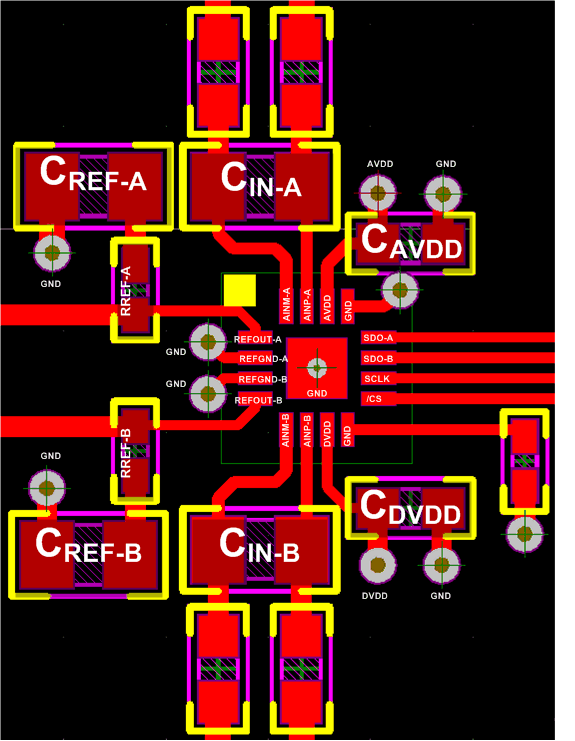SBAS587A January 2014 – April 2014 ADS7251 , ADS7851
PRODUCTION DATA.
- 1 Features
- 2 Applications
- 3 Description
- 4 Revision History
- 5 Terminal Configuration and Functions
-
6 Specifications
- 6.1 Absolute Maximum Ratings
- 6.2 Handling Ratings
- 6.3 Recommended Operating Conditions
- 6.4 Thermal Information
- 6.5 Electrical Characteristics: ADS7251
- 6.6 Electrical Characteristics: ADS7851
- 6.7 Electrical Characteristics: Common
- 6.8 ADS7251 Timing Characteristics
- 6.9 ADS7851 Timing Characteristics
- 6.10 Typical Characteristics: ADS7251
- 6.11 Typical Characteristics: ADS7851
- 6.12 Typical Characteristics: Common
- 7 Detailed Description
- 8 Application and Implementation
- 9 Power Supply Recommendations
- 10Layout
- 11Device and Documentation Support
- 12Mechanical, Packaging, and Orderable Information
Package Options
Mechanical Data (Package|Pins)
- RTE|16
Thermal pad, mechanical data (Package|Pins)
- RTE|16
Orderable Information
10 Layout
10.1 Layout Guidelines
Figure 52 shows a board layout example for the ADS7251 and ADS7851. Use a ground plane underneath the device and partition the PCB into analog and digital sections. Avoid crossing digital lines with the analog signal path and keep the analog input signals and the reference input signals away from noise sources. As shown in Figure 52, the analog input and reference signals are routed on the left side of the board and the digital connections are routed on the right side of the device.
The power sources to the device must be clean and well-bypassed. Use 10-μF, ceramic bypass capacitors in close proximity to the analog (AVDD) and digital (DVDD) power-supply pins. Avoid placing vias between the AVDD and DVDD pins and the bypass capacitors. Connect all ground pins to the ground plane using short, low-impedance paths.
The REFOUT-A and REFOUT-B reference outputs are bypassed with 10-μF, X7R-grade ceramic capacitors (CREF-x). Place the reference bypass capacitors as close as possible to the reference REFOUT-x pins and connect the bypass capacitors using short, low-inductance connections. Avoid placing vias between the REFOUT-x pins and the bypass capacitors. Small 0.1-Ω to 0.2-Ω resistors (RREF-x) are used in series with the reference bypass capacitors to improve stability.
The fly-wheel RC filters are placed immediately next to the input pins. Among ceramic surface-mount capacitors, COG (NPO) ceramic capacitors provide the best capacitance precision. The type of dielectric used in COG (NPO) ceramic capacitors provides the most stable electrical properties over voltage, frequency, and temperature changes. Figure 52 shows CIN-A and CIN-B filter capacitors placed across the analog input pins of the device.
10.2 Layout Example
 Figure 52. Example Layout for the ADS7251 and ADS7851
Figure 52. Example Layout for the ADS7251 and ADS7851